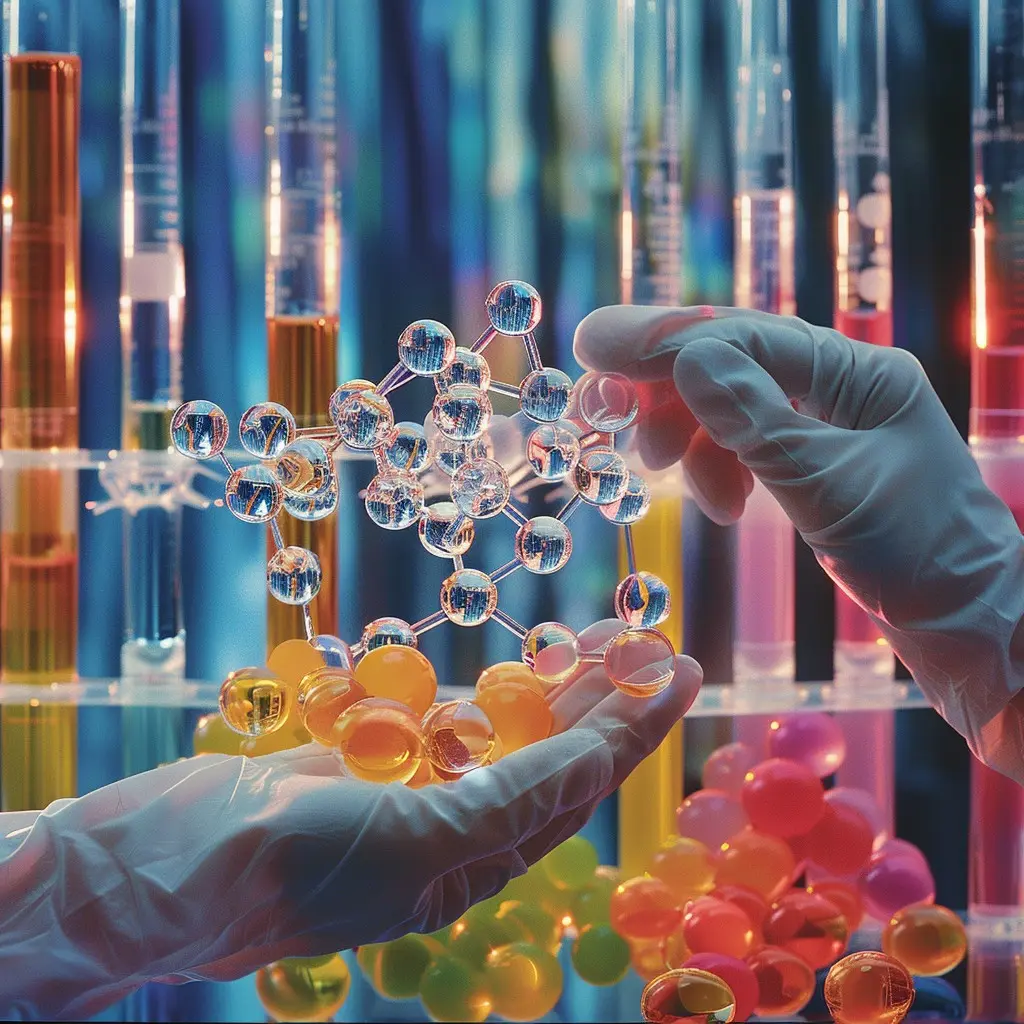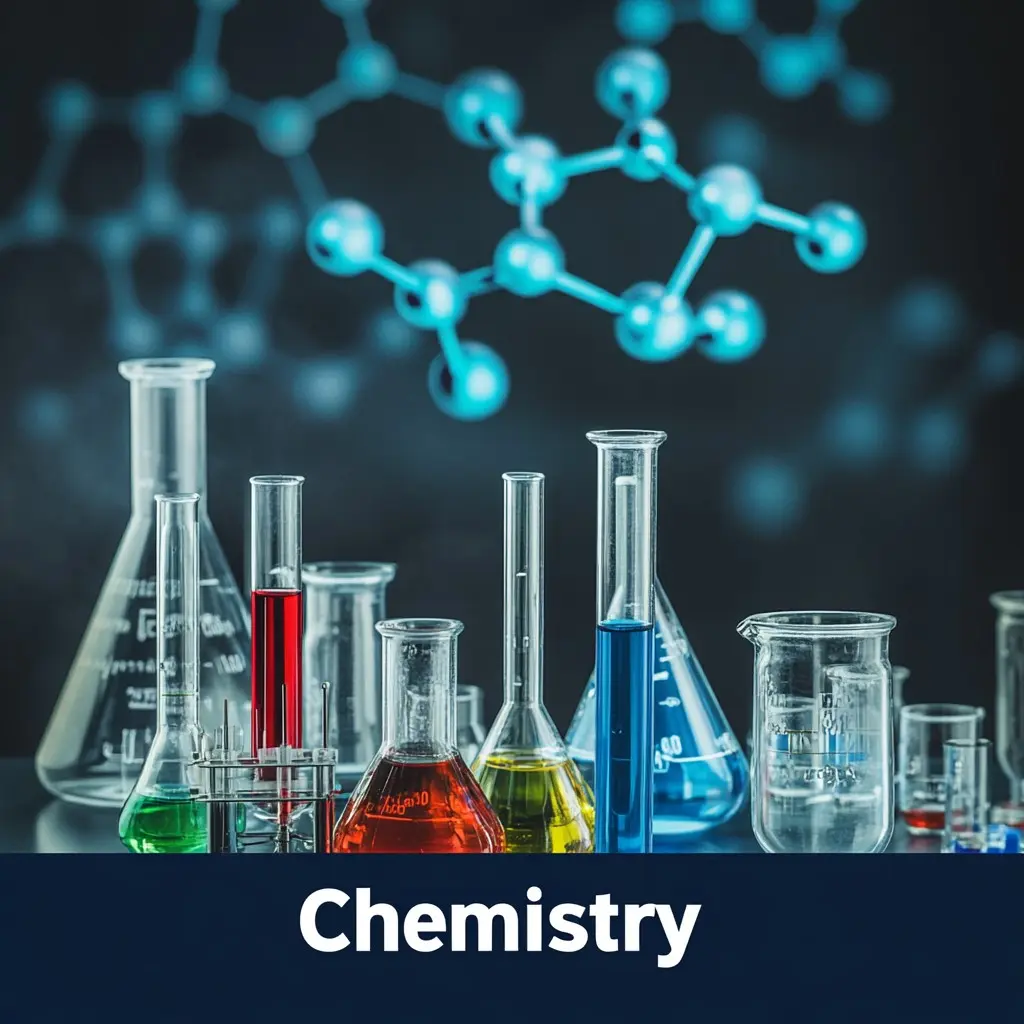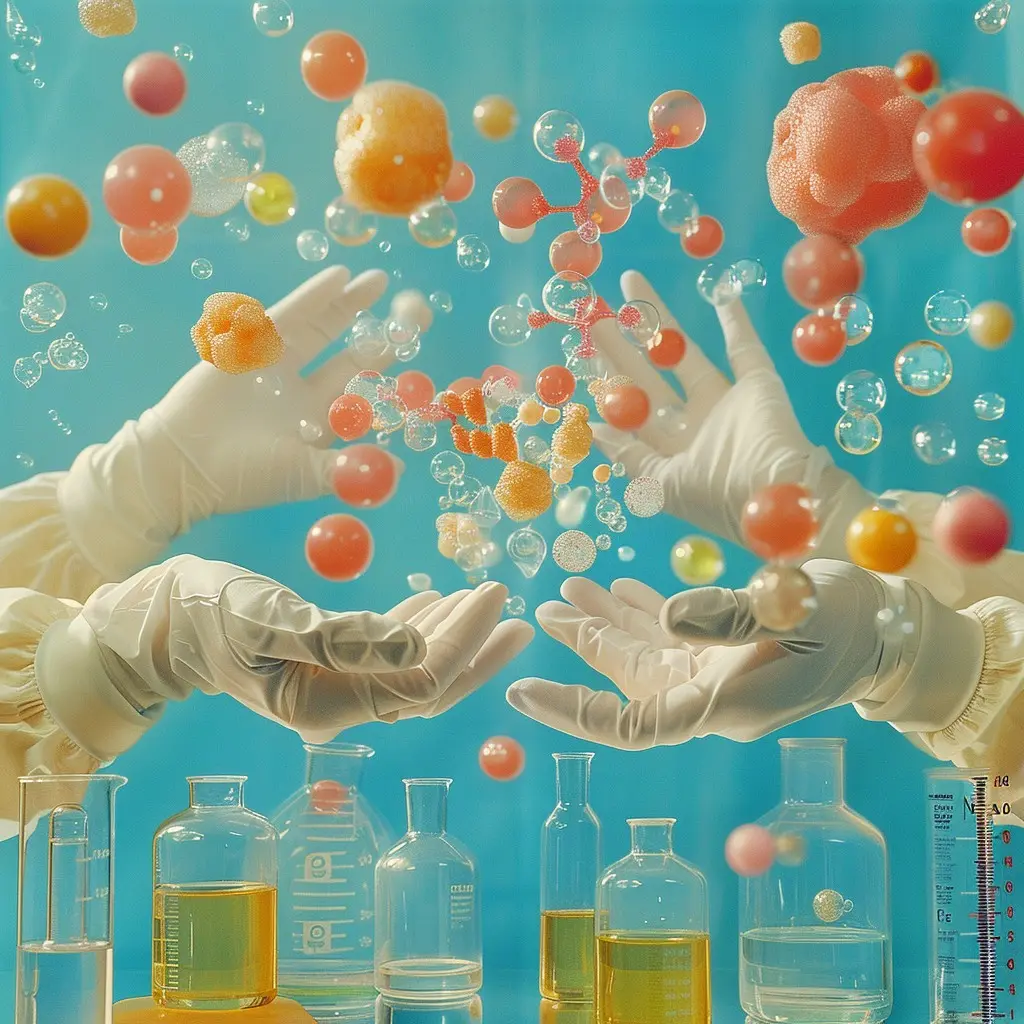Chemistry Quiz: Test Your Knowledge with 100 Challenging Questions!
Dive into the fascinating world of chemistry with our ultimate quiz! Whether you’re a student, a professional, or just a science enthusiast, our 100 chemistry questions cover everything from fundamental concepts to advanced topics.
Challenge yourself, learn new facts, and see how much you really know about the elements, reactions, and the principles that shape our world. Ready to test your chemical savvy? Let’s get started!
See also our Trivia quiz game generator or Fun Facts quiz game for even more fun!



Basic Chemistry
1. What is the atomic number of Hydrogen?
Answer: 1
The atomic number of Hydrogen is 1, indicating it has one proton.
2. What is the chemical symbol for Gold?
Answer: Au
Gold is represented by the symbol Au on the periodic table.
3. What is the most abundant gas in Earth’s atmosphere?
Answer: Nitrogen
Nitrogen makes up about 78% of Earth’s atmosphere.
4. What is the chemical formula for table salt?
Answer: NaCl
Table salt is composed of sodium (Na) and chloride (Cl) ions.
5. What is the pH range of pure water?
Answer: 7
Pure water has a neutral pH of 7.
Chemical Reactions
6. What is the term for a reaction that absorbs heat?
Answer: Endothermic
Endothermic reactions take in heat from the surroundings.
7. What is the process by which a solid turns directly into a gas?
Answer: Sublimation
Sublimation is the transition of a substance from solid to gas without passing through the liquid phase.
8. What type of reaction involves the exchange of ions between two compounds?
Answer: Double Displacement
In a double displacement reaction, ions from two compounds exchange places.
9. What is the term for a reaction that releases energy in the form of heat?
Answer: Exothermic
Exothermic reactions release heat energy to the surroundings.
10. What is the general form of a combustion reaction?
Answer: Hydrocarbon + O₂ → CO₂ + H₂O
Combustion reactions typically involve hydrocarbons reacting with oxygen to produce carbon dioxide and water.
Atomic Structure
11. What is the center of an atom called?
Answer: Nucleus
The nucleus is the central part of an atom where protons and neutrons are located.
12. What particles are found in the nucleus of an atom?
Answer: Protons and Neutrons
The nucleus contains protons and neutrons.
13. What is the charge of an electron?
Answer: Negative
Electrons have a negative charge.
14. What is the term for atoms of the same element with different numbers of neutrons?
Answer: Isotopes
Isotopes are variants of a particular chemical element that have the same number of protons but different numbers of neutrons.
15. What is the term for the number of protons in the nucleus of an atom?
Answer: Atomic Number
The atomic number indicates the number of protons in an atom’s nucleus.
Chemical Bonding
16. What type of bond involves the sharing of electron pairs between atoms?
Answer: Covalent Bond
In a covalent bond, atoms share electron pairs.
17. What is the type of bond that forms between a metal and a non-metal through the transfer of electrons?
Answer: Ionic Bond
Ionic bonds form through the transfer of electrons from metals to non-metals.
18. What is the name for a bond formed by the overlap of atomic orbitals?
Answer: Sigma Bond
A sigma bond is formed by the head-on overlap of atomic orbitals.
19. What is the name for a bond formed when p orbitals overlap side-by-side?
Answer: Pi Bond
Pi bonds are formed by the side-by-side overlap of p orbitals.
20. What is the bond angle in a tetrahedral molecule?
Answer: 109.5°
Tetrahedral molecules have bond angles of 109.5°.
Solutions and Mixtures
21. What is the term for a mixture where the solute is evenly distributed throughout the solvent?
Answer: Homogeneous Mixture
Homogeneous mixtures have a uniform composition throughout.
22. What is the term for a mixture where different components can be visibly distinguished?
Answer: Heterogeneous Mixture
Heterogeneous mixtures have visibly different components.
23. What is the process of a solid dissolving in a liquid called?
Answer: Dissolution
Dissolution is the process where a solid (solute) dissolves in a liquid (solvent).
24. What is the term for the maximum amount of solute that can dissolve in a solvent at a given temperature?
Answer: Solubility
Solubility refers to the maximum concentration of a solute that can be dissolved in a solvent.
25. What is the term for a solution that contains more solute than it can normally hold at a given temperature?
Answer: Supersaturated Solution
Supersaturated solutions have more solute than the solvent can typically dissolve at that temperature.
Thermodynamics
26. What is the term for the measure of the average kinetic energy of particles in a substance?
Answer: Temperature
Temperature measures the average kinetic energy of particles.
27. What is the first law of thermodynamics?
Answer: Energy cannot be created or destroyed, only transferred or converted.
The first law of thermodynamics is the principle of conservation of energy.
28. What is the term for the heat required to raise the temperature of a substance?
Answer: Heat Capacity
Heat capacity is the amount of heat needed to change the temperature of a substance.
29. What is the term for the change in enthalpy during a chemical reaction?
Answer: ΔH (Delta H)
ΔH represents the change in enthalpy during a reaction.
30. What is the term for the amount of heat absorbed or released during a chemical reaction?
Answer: Enthalpy
Enthalpy is the total heat content of a system, reflecting the heat absorbed or released.
Organic Chemistry
31. What is the general formula for alkanes?
Answer: CnH2n+2
Alkanes are hydrocarbons with the general formula CnH2n+2.
32. What is the name for a hydrocarbon with at least one double bond?
Answer: Alkene
Alkenes are hydrocarbons with one or more double bonds.
33. What is the term for a hydrocarbon with a triple bond?
Answer: Alkyne
Alkynes are hydrocarbons with at least one triple bond.
34. What is the name for a molecule that has a functional group of -OH?
Answer: Alcohol
Alcohols contain a hydroxyl (-OH) group.
35. What is the name for a hydrocarbon that contains a benzene ring?
Answer: Aromatic Hydrocarbon
Aromatic hydrocarbons contain a benzene ring structure.
Chemical Equilibrium
36. What is the term for the state in which the forward and reverse rates of a reaction are equal?
Answer: Equilibrium
At equilibrium, the rates of the forward and reverse reactions are equal.
37. What is the principle that states a system at equilibrium will adjust to counteract any changes?
Answer: Le Chatelier’s Principle
Le Chatelier’s Principle predicts how a system at equilibrium responds to changes.
38. What is the term for the ratio of the concentration of products to reactants at equilibrium?
Answer: Equilibrium Constant
The equilibrium constant (K) reflects the ratio of product to reactant concentrations.
39. What is the term for a reaction that proceeds in only one direction and does not reach equilibrium?
Answer: Irreversible Reaction
Irreversible reactions proceed only in one direction and do not reach a state of equilibrium.
40. What is the term for the rate at which a reaction proceeds?
Answer: Reaction Rate
The reaction rate measures how quickly reactants are converted into products.
Acids and Bases
41. What is the term for a substance that donates a proton (H+) in a reaction?
Answer: Acid
Acids are proton donors in chemical reactions.
42. What is the term for a substance that accepts a proton (H+) in a reaction?
Answer: Base
Bases are proton acceptors in chemical reactions.
43. What is the pH range for acids?
Answer: 0-6.9
Acids have a pH range from 0 to just below 7.
44. What is the pH range for bases?
Answer: 7.1-14
Bases have a pH range from just above 7 to 14.
45. What is the term for a solution that resists changes in pH when acids or bases are added?
Answer: Buffer
Buffers maintain a relatively constant pH in a solution.
Chemical Kinetics
46. What is the term for the minimum energy required for a reaction to occur?
Answer: Activation Energy
Activation energy is the energy barrier that must be overcome for a reaction to proceed.
47. What is the term for the speed of a chemical reaction?
Answer: Reaction Rate
Reaction rate measures how quickly reactants are converted into products.
48. What is the term for a substance that increases the rate of a reaction without being consumed?
Answer: Catalyst
Catalysts speed up reactions by lowering the activation energy.
49. What is the term for a reaction where the rate depends on the concentration of only one reactant?
Answer: First-Order Reaction
In first-order reactions, the rate depends on the concentration of one reactant.
50. What is the term for a reaction where the rate depends on the concentration of two reactants?
Answer: Second-Order Reaction
Second-order reactions depend on the concentration of two reactants.
Chemical Bonding
51. What is the term for a bond formed by the electrostatic attraction between positively and negatively charged ions?
Answer: Ionic Bond
Ionic bonds result from the electrostatic attraction between charged ions.
52. What is the term for a bond where electrons are shared equally between two atoms?
Answer: Nonpolar Covalent Bond
Nonpolar covalent bonds involve equal sharing of electrons.
53. What is the term for a bond where electrons are shared unequally between two atoms?
Answer: Polar Covalent Bond
Polar covalent bonds involve unequal sharing of electrons.
54. What is the term for the three-dimensional arrangement of atoms in a molecule?
Answer: Molecular Geometry
Molecular geometry describes the three-dimensional arrangement of atoms.
55. What is the name of the bond angle in a water molecule?
Answer: 104.5°
The bond angle in a water molecule is approximately 104.5°.
Organic Chemistry
56. What is the name for a compound with a carbonyl group (C=O) and a hydroxyl group (-OH)?
Answer: Carboxylic Acid
Carboxylic acids contain both a carbonyl and a hydroxyl group.
57. What is the term for a hydrocarbon chain with all single bonds?
Answer: Saturated Hydrocarbon
Saturated hydrocarbons have only single bonds between carbon atoms.
58. What is the name for a hydrocarbon with a double bond and no rings?
Answer: Alkene
Alkenes have one or more double bonds in their structure.
59. What is the term for a hydrocarbon with a triple bond and no rings?
Answer: Alkyne
Alkynes have one or more triple bonds.
60. What is the name for a hydrocarbon that contains a benzene ring?
Answer: Aromatic Hydrocarbon
Aromatic hydrocarbons include compounds with benzene rings.
Environmental Chemistry
61. What is the term for the gradual increase in Earth’s average temperature due to increased greenhouse gases?
Answer: Global Warming
Global warming refers to the rise in Earth’s average temperature.
62. What is the term for chemicals that break down the ozone layer?
Answer: CFCs (Chlorofluorocarbons)
CFCs are compounds that contribute to ozone layer depletion.
63. What is the term for the process of removing contaminants from soil and water?
Answer: Remediation
Remediation involves cleaning up contaminated soil and water.
64. What is the term for chemicals that persist in the environment and accumulate in living organisms?
Answer: Persistent Organic Pollutants (POPs)
POPs are chemicals that remain in the environment and bioaccumulate.
65. What is the term for the process by which green plants convert sunlight into chemical energy?
Answer: Photosynthesis
Photosynthesis is the process where plants convert sunlight into chemical energy.
Biochemistry
66. What is the term for the building blocks of proteins?
Answer: Amino Acids
Amino acids are the monomers that make up proteins.
67. What is the term for the process by which DNA is replicated?
Answer: DNA Replication
DNA replication is the process of copying DNA before cell division.
68. What is the term for the genetic material found in cells?
Answer: DNA (Deoxyribonucleic Acid)
DNA carries genetic information in cells.
69. What is the term for the process where RNA is used to synthesize proteins?
Answer: Translation
Translation is the process where RNA is translated into a protein sequence.
70. What is the term for the energy currency of the cell?
Answer: ATP (Adenosine Triphosphate)
ATP provides energy for various cellular processes.
Advanced Chemistry
71. What is the term for the study of carbon-containing compounds?
Answer: Organic Chemistry
Organic chemistry focuses on carbon-based compounds.
72. What is the term for the change in energy that occurs when a substance changes from a solid to a liquid?
Answer: Heat of Fusion
Heat of fusion is the energy required for a substance to melt.
73. What is the term for the process of forming a solid from a solution?
Answer: Precipitation
Precipitation is the formation of a solid from a liquid solution.
74. What is the term for the measure of how much a substance can dissolve in a solvent?
Answer: Solubility
Solubility measures the maximum amount of solute that can dissolve in a solvent.
75. What is the term for a reaction that involves the transfer of electrons between substances?
Answer: Redox Reaction
Redox reactions involve the transfer of electrons between reactants.
Analytical Chemistry
76. What is the term for the technique used to separate mixtures into their individual components?
Answer: Chromatography
Chromatography separates components of a mixture based on their interactions with a stationary and mobile phase.
77. What is the term for the technique used to identify the composition of a substance?
Answer: Spectroscopy
Spectroscopy identifies substances based on their interaction with light.
78. What is the term for the process of measuring the concentration of a solute in a solution?
Answer: Titration
Titration determines the concentration of a solute by reacting it with a reagent.
79. What is the term for the technique used to determine the molecular weight of a compound?
Answer: Mass Spectrometry
Mass spectrometry measures the mass-to-charge ratio of ions to determine molecular weight.
80. What is the term for the process of determining the purity of a substance?
Answer: Purity Analysis
Purity analysis assesses the extent to which a substance is free from contaminants.
Chemical Engineering
81. What is the term for the process of converting raw materials into useful products through chemical reactions?
Answer: Chemical Process
Chemical processes transform raw materials into products through chemical reactions.
82. What is the term for the study of the design and operation of chemical reactors?
Answer: Chemical Reaction Engineering
Chemical reaction engineering focuses on the design and operation of reactors for chemical reactions.
83. What is the term for the process of scaling up a chemical reaction from laboratory to industrial scale?
Answer: Scale-Up
Scale-up involves adapting laboratory processes for industrial production.
84. What is the term for the study of the flow of fluids in chemical processes?
Answer: Fluid Dynamics
Fluid dynamics examines how fluids move and interact in chemical processes.
85. What is the term for the process of separating a mixture into its individual components based on their boiling points?
Answer: Distillation
Distillation separates components based on differences in boiling points.
Chemical Safety
86. What is the term for the precautionary measures taken to prevent accidents in the laboratory?
Answer: Safety Protocols
Safety protocols are guidelines to ensure safe practices in the laboratory.
87. What is the term for the standard practice of labeling chemical containers with their contents and hazards?
Answer: Labeling
Labeling involves marking chemical containers with information about their contents and associated hazards.
88. What is the term for the equipment used to protect laboratory workers from exposure to harmful substances?
Answer: Personal Protective Equipment (PPE)
PPE includes items like gloves, goggles, and lab coats that protect workers from hazardous materials.
89. What is the term for the practice of disposing of chemical waste in accordance with regulations?
Answer: Waste Management
Waste management involves the proper disposal of chemical waste to minimize environmental impact.
90. What is the term for the systematic study of chemical reactions and their hazards in the laboratory?
Answer: Risk Assessment
Risk assessment evaluates the potential hazards associated with chemical reactions and laboratory processes.
Physical Chemistry
91. What is the term for the study of how temperature affects the rate of chemical reactions?
Answer: Chemical Kinetics
Chemical kinetics studies the effect of temperature on reaction rates.
92. What is the term for the process of dissolving a solute in a solvent?
Answer: Dissolution
Dissolution is the process by which a solute mixes with a solvent to form a solution.
93. What is the term for the energy required to break a chemical bond?
Answer: Bond Dissociation Energy
Bond dissociation energy is the amount of energy needed to break a chemical bond.
94. What is the term for the study of the energy changes during chemical reactions?
Answer: Thermochemistry
Thermochemistry examines the heat changes that occur during chemical reactions.
95. What is the term for the equilibrium constant of a reaction in terms of concentrations of products and reactants?
Answer: Reaction Quotient
The reaction quotient describes the ratio of the concentrations of products to reactants at any point during the reaction.
Environmental Chemistry
96. What is the term for the release of harmful substances into the atmosphere from industrial processes?
Answer: Pollution
Pollution refers to the introduction of contaminants into the environment.
97. What is the term for the process of capturing and storing carbon dioxide emissions from industrial sources?
Answer: Carbon Capture and Storage (CCS)
CCS involves capturing and storing carbon dioxide to reduce atmospheric emissions.
98. What is the term for the study of the effects of chemicals on living organisms and ecosystems?
Answer: Environmental Toxicology
Environmental toxicology assesses the impact of chemicals on ecosystems and living organisms.
99. What is the term for the process of restoring natural environments that have been degraded by human activity?
Answer: Environmental Restoration
Environmental restoration aims to return degraded ecosystems to their natural state.
100. What is the term for the practice of reducing, reusing, and recycling materials to minimize waste?
Answer: Waste Reduction
Waste reduction involves strategies to minimize waste production and promote recycling.
Reference
- Ins and Outs of Chemistry Quiz | Britannica – Test your knowledge of chemical elements, compounds, and processes with this quiz from Encyclopaedia Britannica.
- 484+ Best Chemistry Trivia Questions & Answers | TriviaNerd – A comprehensive collection of chemistry trivia questions covering compounds, reactions, combinations, and more.
- GCSE Chemistry Revision Quiz Based on Past Papers | BBC Bitesize – A quick-fire 10 question quiz suitable for GCSE chemistry students revising topics like the periodic table and equations.
- 50 Awesome Science Trivia Questions! | Great Wolf Lodge – Includes a section with chemistry trivia questions on topics such as the periodic table, radiation, and chemical reactions.
- Scientists and Their Inventions Quiz | Britannica – While not solely focused on chemistry, this quiz tests your knowledge of famous scientists and their contributions to various fields, including chemistry.




